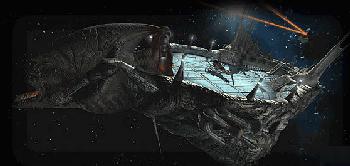What do Wagner, Volkswagen, and the 1936 Olympics have to do with each other?
Time for a history lesson. I had an incredibly evil history teacher, back
in the days, so I’ll make this short. Richard Wagner was one of the 19th century’s
most famous composers. He wrote many operas and pieces, and was beloved by many…
even the Nazis. Actually, the Nazis especially loved his work — they felt it
epitomized the Nietzschean spirit of the superman. Anyway, Wagner’s master work,
Ring of the Nibelungen, took obscure Germanic mythology and tied it with
an immensely long opera about the birth of the cosmos and the complexity of the
human soul. The complete opera fills 14 CDs.
Ring takes Wagner’s opera, mixes in a science fiction element, and
tries to come up with a game. You play Ish, a Metascientist in the year 4000.
You are allowed to view and take part in the lives of four others, in order to
learn what caused man’s downfall. Those four are: a dwarf, a fire spirit, a half-wolf
creature, and a valkyrie.
I’m compelled
to talk about the good within this game first, because it’s as short as my history
lesson. The music, taken from a recording by the Vienna Symphony, is moving and
powerful. Even running in a loop, each short instrumental sequence sounded beautiful.
I think other games ought to implement classical pieces to enrich their own music
(Two examples are Final Fantasy 8’s
Liberi Fatali, and The Dig, which also had Wagner and is much better than
Ring).
Ring can best be typed as a graphical point and click adventure with
puzzle elements, sort of Monkey Island mixed with Myst. I’ve always
loved point and click games; one of my all time favorite PC games is the classic
Sam and Max: Freelance Police. What made these old games into classics
were: straightforward interface, gameplay, logical puzzles, and involving elements.
Ring has none of these.
The basic interface has you move your mouse to look around your environment.
Basically this design works by placing you within a cylinder. The graphics are
mapped around the inside of the cylinder. You turn around in your cylinder to
look at your environment. Your cursor slightly changes to indicate what you’re
pointing at: an object, a direction you can travel, etc. In many ways, this game
is similar to Reah, only without the sharp graphics and
puzzles that make less sense. The cursors way-too-minor changes and the hard to
find “hot spots” on the environment result in a very muddled interface.
Ring purportedly offers you non-linear gameplay. What it really gives
you is the choice between playing as one of four characters. When you get too
frustrated with one character, you can switch to another one and get even more
frustrated. Each character works on a strictly linear sequence-you must complete
“X” in order to go on to “Y”. Choosing between more than one linear option is
not the same as non-linear game.
The puzzles don’t have the all-important element of logic to them. For example
— How do you start a motorcycle? Obviously, by sticking a Glug monster in it
and feeding it minerals. Riiiight. Even with trial and error, these puzzles don’t
click. Do one thing wrong and it’s instant death for you. Who wants to play a
game where you just try to use every object in the inventory on every environmental
object?
You have to ask yourself: What kind of game prints the entire walkthrough in
the instruction manual? And then ask: What kind of game is so unclear, that even
their walkthrough won’t help?
 Point
Point
and click games have always included the unfortunate task of having to run your
mouse across the screen just to find a tiny object. Well now instead of just one
screen, you have to run that mouse across your entire rotating cylinder. The pseudo
3D doesn’t pull the player into the game. Older point and clicks let you talk
to people and choose questions and responses towards them. That was called involvement.
In Ring, you watch a sequence. Then you turn around, a lot, looking for
“hot spots,” and then watch another sequence. It’s about as involving as channel
surfing.
How best to describe the graphics? What words can best convey the emotions
that I felt? Hrmmm…. pixelated crap! What’s especially sad about the graphics
is that underneath all that pixelation, there was once a beautiful sense of artistic
design. The characters and their costumes have originality that would have looked
great if only they were clear. The blame can all be pointed at the software; the
game works strictly off its own graphics engine, which uses lousy, compressed
pre-renders. So, it doesn’t even matter how powerful your computer is or that
you have Voodoo chips stuffed up your nose — you’ll still be looking at pixelated
crap.
The voices in the game are more Looney Tunes than opera (although not as good
as that Elmer Fudd opera, "Kill the wabbit!"). The blatant contrast
of the wacky voices to the excellent, professional, classical music just weakens
the strength of the musical score.
The only pearls in this mess is the original art behind the game and the music.
Poor Richard Wagner is probably rolling in his grave. Even if it had the graphics,
without strong gameplay and logical puzzles, Ring snaps under its own weighted
ambitions. Don’t let the images of the almost naked girls on the back of their
box deceive you — they’re probably straight off some SGI workstatation. Just
remember this: The Nazis almost dragged Wagner down with them, don’t let Ring
finish the job.

-
Great musical score
-
Bad like the Nazis
-
Piss poor pixelated graphics
-
Puzzles that lack logic
-
Interface that makes the game less involving







